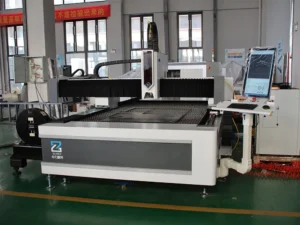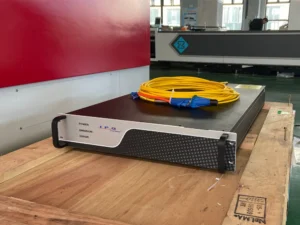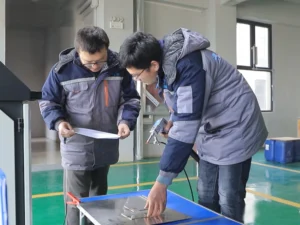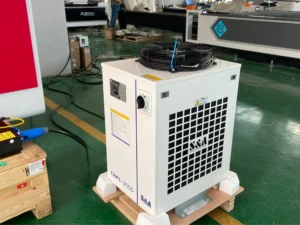Introduction:
A fiber laser cutting machine uses a high-powered fiber laser to cut through a variety of materials with high precision and speed. The laser is generated by passing an electric current through a fiber optic cable, which creates a concentrated beam of light that is focused onto the material being cut.
The machine’s computer system controls the laser’s intensity, duration, and position, ensuring accurate and efficient cutting. Fiber laser cutting machines are commonly used in the manufacturing industry for cutting metal sheets, pipes, and other materials. They are popular due to their low maintenance costs, high energy efficiency, and precise cutting capabilities.
To reduce the failure rate of fiber laser machine, increase the service life of the product, and reduce the loss caused by the customer’s mistake in operating the machine, the operator should pay attention to the following items when operating the machine:

-
Fiber laser cutting machine startup sequence
The startup sequence of a fiber laser cutting machine may vary slightly depending on the model and manufacturer.
1. Power on the machine: Ensure that the machine is properly connected to the power supply and turn on the main power switch.
2. Check the water supply: Check the water supply for the cooling system, and make sure that the water is flowing properly through the system.
3. Connect the air supply: Connect the compressed air supply to the machine. The air supply is used to blow away the material debris during cutting.
4. Turn on the laser source: Turn on the laser source and wait for it to warm up. This may take a few minutes depending on the power of the laser.

5. Align the beam: Align the laser beam with the cutting head using the alignment tool.
6. Load the material: Load the material to be cut onto the worktable and secure it in place.
7. Set the cutting parameters: Set the cutting parameters, such as power, speed, and focus.
8. Start the cutting process: Press the start button to begin the cutting process.
It is important to follow the manufacturer’s instructions and safety guidelines when operating a fiber laser cutting machine.
-
Fiber laser shutdown sequence
The shutdown sequence of a fiber laser cutting machine may vary slightly depending on the model and manufacturer. In general, however, the shutdown sequence involves the following steps:
1. Stop the cutting process: Press the stop button to stop the laser cutting process.
2. Turn off the laser source: Turn off the laser source to prevent it from damaging the machine components.
3. Turn off the chiller unit: Turn off the chiller unit to stop the water flow and prevent the laser source from overheating.
4. Disconnect the air supply: Disconnect the compressed air supply from the machine.

5. Remove the material: Remove the material from the work table and clean any debris left on the table or inside the machine.
6. Turn off the power: Turn off the main power switch and unplug the machine from the power supply.
7. Secure the safety cover: Close and secure the safety cover to prevent unauthorized access to the machine.
It is important to follow the manufacturer’s instructions and safety guidelines when shutting down a fiber laser-cutting machine to avoid any potential damage or injury.
-
Machine quick start operation skills
Quick start operation skills for a fiber laser cutting machine include the following:
1. Familiarize yourself with the machine’s operation: Take the time to read through the machine’s manual and learn about its different components and features.
2. Preheat the machine: If the machine has been idle for a while, it may be necessary to preheat it to avoid thermal shock. Turn on the laser source and let it warm up for a few minutes before use.
3. Keep the machine clean: Regularly clean the worktable, cutting head, and other components to ensure optimal performance and prevent damage.

4. Use the correct settings: Set the machine parameters, such as power, speed, and focus, based on the material being cut. Using incorrect settings can damage the machine or produce poor-quality cuts.
5. Monitor the cutting process: Keep an eye on the cutting process, particularly if cutting a new material or using a new program. Adjust the settings as necessary to achieve the desired quality and accuracy.
6. Use proper safety measures: Always wear protective gear, such as glasses and gloves, when operating a fiber laser cutting machine. Follow all safety instructions and guidelines to avoid injury.
7. Regular maintenance: Regularly inspect and maintain the machine to ensure it is in working order. This can prevent any potential breakdown during the cutting process.
By following these quick-start operation skills, it is possible to operate a fiber laser cutting machine safely and efficiently.
-
Environmental requirements for placing fiber lasers on site
The on-site placement of fiber laser cutting machines requires certain environmental conditions. These include:
1. Temperature: The ideal temperature for a fiber laser cutting machine is between 15°C and 30°C. Extreme temperatures can cause thermal shock to the machine’s components, affecting its accuracy and performance.
2. Humidity: The ideal humidity range for a fiber laser cutting machine is between 45% and 75%. High humidity can cause rust and corrosion, while low humidity can cause static electricity buildup.
3. Ventilation: The machine should be placed in a well-ventilated area with proper air circulation. This helps to prevent the buildup of fumes and dust, which can be harmful to the operator and the machine.
4. Power supply: The machine should be connected to a stable and grounded power supply to prevent power fluctuations or surges that can damage the machine’s components.
5. Space: The machine should be placed in an area that provides adequate space for the operator to move around and perform maintenance. There should also be enough space for the material to be loaded safely onto the worktable.
6. Noise: Fiber laser cutting machines produce noise during operation, which can be disturbing to people nearby.
It is important to follow the manufacturer’s recommendations for environmental requirements to ensure the safe and optimal operation of the fiber laser cutting machine.
-
Requirements for cooling water of fiber laser
Fiber laser cooling water should be replaced every three months. Cooling water should be distilled water.

Conductivity requirements: 30us/cm<conductivity<50us/cm. When adding tap water, pay attention to monitoring the conductivity value to avoid excessive conductivity.
-
Make sure the laser chassis is airtight
The fiber laser case adopts an airtight design. Please keep the case tightly closed during use to prevent external high-temperature and high-humidity air from entering the case. Check the airtightness of the chassis should pay attention to the following aspects:
1. Check whether the door of the laser cabinet is closed tightly and whether the lifting bolts on the top are tightened. Check whether the protective cover of the unused communication control interface at the rear of the cabinet is covered. And check whether the power cord inlet is sealed, etc.
2. If the laser needs to open the cabinet door for some reason during use, it is necessary to turn off the chiller first and then open the cabinet door. First, turn on the power switch of the laser and run it for more than 60 minutes. Then turn on the chiller. Wait until the actual temperature of the high and low temperature of the chiller reaches the set temperature ± 1°C, then turn on the fiber laser at high pressure.
